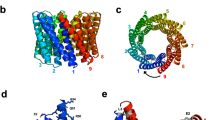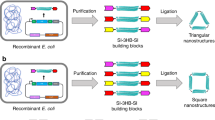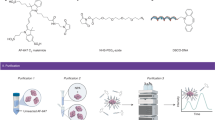Abstract
Protein engineering has enabled the design of molecular scaffolds that display a wide variety of sizes, shapes, symmetries and subunit compositions. Symmetric protein-based nanoparticles that display multiple protein domains can exhibit enhanced functional properties due to increased avidity and improved solution behavior and stability. Here we describe the creation and characterization of a computationally designed circular tandem repeat protein (cTRP) composed of 24 identical repeated motifs, which can display a variety of functional protein domains (cargo) at defined positions around its periphery. We demonstrate that cTRP nanoparticles can self-assemble from smaller individual subunits, can be produced from prokaryotic and human expression platforms, can employ a variety of cargo attachment strategies and can be used for applications (such as T-cell culture and expansion) requiring high-avidity molecular interactions on the cell surface.
This is a preview of subscription content, access via your institution
Access options
Access Nature and 54 other Nature Portfolio journals
Get Nature+, our best-value online-access subscription
$29.99 / 30 days
cancel any time
Subscribe to this journal
Receive 12 print issues and online access
$189.00 per year
only $15.75 per issue
Buy this article
- Purchase on Springer Link
- Instant access to full article PDF
Prices may be subject to local taxes which are calculated during checkout






Similar content being viewed by others
References
Itzhaki, L. S. & Lowe, A. R. From artificial antibodies to nanosprings: the biophysical properties of repeat proteins. Adv. Exp. Med. Biol. 747, 153–166 (2012).
Matsushima, N., Tanaka, T. & Kretsinger, R. H. Non-globular structures of tandem repeats in proteins. Protein Pept. Lett. 16, 1297–1322 (2009).
Javadi, Y. & Itzhaki, L. S. Tandem-repeat proteins: regularity plus modularity equals design-ability. Curr. Opin. Struct. Biol. 23, 622–631 (2013).
Schilling, J., Schoppe, J. & Pluckthun, A. From DARPins to LoopDARPins: novel LoopDARPin design allows the selection of low picomolar binders in a single round of ribosome display. J. Mol. Biol. 426, 691–721 (2014).
Zhao, Y.-Y. et al. Expanding RNA binding specificity and affinity of engineered PUF domains. Nucleic Acids Res. 46, 4771–4782 (2018).
Cunha, E. S., Hatem, C. L. & Barrick, D. Insertion of endocellulase catalytic domains into thermostable consensus ankyrin scaffolds: effects on stability and cellulolytic activity. Appl. Environ. Microbiol. 79, 6684–6696 (2013).
Park, K. et al. Control of repeat-protein curvature by computational protein design. Nat. Struct. Mol. Biol. 22, 167–174 (2015).
Cheng, C. Y., Jarymowycz, V. A., Cortajarena, A. L., Regan, L. & Stone, M. J. Repeat motions and backbone flexibility in designed proteins with different numbers of identical consensus tetratricopeptide repeats. Biochemistry 45, 12175–12183 (2006).
Kajander, T., Cortajarena, A. L., Mochrie, S. & Regan, L. Structure and stability of designed TPR protein superhelices: unusual crystal packing and implications for natural TPR proteins. Acta Crystallogr. D Biol. Crystallogr. 63, 800–811 (2007).
Shen, H. et al. De novo design of self-assembling helical protein filaments. Science 362, 705–709 (2018).
Doyle, L. et al. Rational design of alpha-helical tandem repeat proteins with closed architectures. Nature 528, 585–588 (2015).
Frese, S. et al. The phosphotyrosine peptide binding specificity of Nck1 and Nck2 Src homology 2 domains. J. Biol. Chem. 281, 18236–18245 (2006).
Zakeri, B. et al. Peptide tag forming a rapid covalent bond to a protein, through engineering a bacterial adhesin. Proc. Natl Acad. Sci. USA 109, E690–E697 (2012).
Lam, A. J. et al. Improving FRET dynamic range with bright green and red fluorescent proteins. Nat. Methods 9, 1005–1012 (2012).
Dou, J. et al. De novo design of a fluorescence-activating beta-barrel. Nature 561, 485–491 (2018).
Yu, Y. Y., Netuschil, N., Lybarger, L., Connolly, J. M. & Hansen, T. H. Cutting edge: single-chain trimers of MHC class I molecules form stable structures that potently stimulate antigen-specific T cells and B cells. J. Immunol. 168, 3145–3149 (2002).
Bandaranayake, A. D. et al. Daedalus: a robust, turnkey platform for rapid production of decigram quantities of active recombinant proteins in human cell lines using novel lentiviral vectors. Nucleic Acids Res. 31, e143 (2011).
Chen, L. & Flies, D. B. Molecular mechanisms of T cell co-stimulation and co-inhibition. Nat. Rev. Immunol. 13, 227–242 (2013).
Taylor, G. K., Heiter, D. F., Pietrokovski, S. & Stoddard, B. L. Activity, specificity and structure of I-Bth0305I: a representative of a new homing endonuclease family. Nucleic Acids Res. 39, 9705–9719 (2011).
Dyer, K. N. et al. High-throughput SAXS for the characterization of biomolecules in solution: a practical approach. Methods Mol. Biol.1091, 245–258 (2014).
Scarff, C. A., Fuller, M. J. G., Thompson, R. F. & Iadaza, M. G. Variations on negative stain electron microscopy methods: tools for tackling challenging systems. J. Vis. Exp. 132, e57199 (2018).
Warren, E. H., Greenberg, P. D. & Riddell, S. R. Cytotoxic T-lymphocyte-defined human minor histocompatibility antigens with a restricted tissue distribution. Blood 91, 2197–2207 (1998).
Acknowledgements
A. Towlerton and E. H. Warren provided materials, advice and facilitation of scMHC tetramer-based flow cytometric experiments. R. Strong provided advice and facilitation of SPR (Biacore) binding experiments. J. Carter provided operations support for mammalian protein production and J. M. Olson provided laboratory support for protein expression. This work was funded by the NIH (grant no. R01 GM123378) and by the Fred Hutchinson Cancer Research Center.
Author information
Authors and Affiliations
Contributions
P.B. conducted the computational protein design work, including fold design and identification of point mutations leading to alteration of self-assembly properties, and generated the structural models used throughout the article. J.H., L.A.D., A.Q., C.P., B.K.K., B.L.S. and R.O.R. all conducted protein expression, purification and biochemical characterization experiments. B.W.S. conducted EM visualization studies. D.J.F. conducted SPR protein-binding studies. Y.X., C.A.J.-R., A.D.B. and S.R.R. designed and conducted T-cell staining studies. C.E.C. and B.L.S. designed functionalized cTRP constructs. C.E.C., B.K.K., B.L.S. and P.B. wrote the manuscript, which was edited extensively by all authors.
Corresponding authors
Ethics declarations
Competing interests
C.E.C., P.B., S.R.R. and B.L.S. are employees of the Fred Hutchinson Cancer Research Center; they are named inventors on intellectual property corresponding to the technology in this article. S.R.R. is a founder of Lyell Immunopharma Inc., which has recently licensed the technology for use in T-cell culture applications.
Additional information
Peer review information Inês Chen was the primary editor on this article and managed its editorial process and peer review in collaboration with the rest of the editorial team.
Publisher’s note Springer Nature remains neutral with regard to jurisdictional claims in published maps and institutional affiliations.
Extended data
Extended Data Fig. 1 Characterization of engineered cTRP24.
a, Circular dichroism (CD) spectra of cTRP24 at 22° and 95 °C shows preservation of secondary structure at high temperature. b, Small angle x-ray scattering (SAXS) spectra measured for cTRP24 (left), calculated SAXS spectrum derived from the atomic model of the designed protein construct (middle) and a superposition of the experimental and calculated spectra (right).
Extended Data Fig. 2 Design and electrophoretic gel visualization of self-assembling, disulfide-stapled cTRP24 nanoparticles.
a, The cTRP2412SS construct, assembled from dimerization of two identical protein subunits each harboring 12 repeats, with the N- and C-terminal repeat of each containing a cysteine residue (described in the main text and in Fig. 2) that enable disulfide stapling. SEC analyses (shown in Fig. 2c) and electrophoretic analyses (right panel) both indicate formation of a dimer that contains a mixture of one or two disulfide staples, both of which behave in solution similarly to a monomeric, single chain 24-repeat cTRP. b, A cTRP246SS construct, assembled from four identical protein subunits each harboring 6 repeats, with the N- and C-terminal repeat of each containing a cysteine residue (described in the main text and in Fig. 2) that enable disulfide stapling. SEC analyses indicate that expression and purification yield a cTRP24 that behaves in solution in a similar manner to a monomeric, single chain 24-repeat cTRP. Electrophoretic analyses of the same construct generated either via cytosolic expression in E. coli (and then oxidized in the presence of air during purification) or via secretion from human HEK cells (oxidized as part of eukaryotic disulfide bond formation mechanism during secretion) indicate that disulfides are formed in both cases. However, expression from bacteria generates a mixture of species (harboring 2, 3 or 4 disulfides), whereas expression and secretion from human cells generated a more homogeneous population of species primarily consisting of a full complement of disulfide bonds.
Extended Data Fig. 3 Functional characterization of additional cTRP constructs.
a, A 24-repeat cTRP harboring four copies of the SpyCatcher protein domain (cTRP2412SS-Spy) is fully conjugated with four copies of SpyTagged Clover (a derivative of GFP). In this reducing SDS-PAGE gel two bands are observed as a result of addition of SpyCatcher, corresponding to capture of 1 or 2 copies of SpyTagged Clover by each 12-repeat protein subunit. b, Fluorescence of free Clover and cTRP2412SS-Spy-Clover nanoparticles, as a function of normalized Clover concentrations. Data shown as mean and s.d. for n=3 independent experiments. c, Four copies an engineered fluorescence activating protein (‘mFAP’) are inserted into four evenly distributed surface loops around the bottom face of the cTRP (‘cTRP246SS-mFAP’). d, Purification and fluorescence activity of cTRP246SS-mFAP. mFAP has previously been demonstrated to fluoresce in the presence of exogenous, bound DHFBI fluorophore. The two curves that demonstrate increasing fluorescence as a function of protein concentration correspond to the cTRP246SS-mFAP (blue) nanoparticle and to free mFAP (red); as in panel b the protein concentrations are normalized relative to the one-versus-four copies of mFAP per molecule. The three curves that do not increase in fluorescence as a function of protein concentration correspond to the ‘naked’ cTRP (cTRP246SS), cTRP246SS plus DHFBI, and DHFBI alone. For the latter two constructs, the DHFBI concentration is equivalent at each protein concentration to that which is present in the active constructs. Data shown as mean and s.d. for n=3 independent experiments.
Extended Data Fig. 4 Detection of CMV pp65-reactive CD8+ T-cells diluted into donor PBMCs using cTRP246SS-scMHC and streptavidin-allophycocyanin (APC) tetramers.
a, Forward versus side scatter plot showing an overlay of CMV pp65-reactive T-cells (red contour plot) and donor PBMCs (blue contour plot) and the lymphocyte gating strategy used for further analysis. This strategy was used to quantitate CMV pp65-reactive T-cells diluted into donor PBMCs as shown in panels c and d. b, Scatter plot showing an overlay of the DAPI-negative lymphocyte gates stained with an anti-His-APC secondary antibody (Biolegend #362605) confirms that the secondary antibody used to detect cTRP246SS-scMHC does not result in unwanted background staining of live cells. c, Representative flow cytometry scatter plot showing quantitation of CMV pp65-reactive T-cells diluted into donor PBMCs at a ratio of 1:4 respectively. d, Quantitation of CMV pp65-reactive T-cells at various dilutions using both the cTRP246SS-scMHC (detected using the anti-His-APC secondary) and streptavidin-APC scMHC tetramer (SA-Tetramer). Note that the ratios in the first column (CMV:PBMC) represent raw cell counts prior to staining.
Extended Data Fig. 5 Expression and preliminary characterization of a hexameric cTRP24 harboring N-terminal cargo and a tetrameric cTRP24 harboring both N- and C-terminal cargos.
a, Schematic showing the architecture of the cTRP244SS-scMHC and corresponding non-reducing and reducing SDS-PAGE following affinity purification. Under reducing conditions, the protein migrates as a monomer. b, Schematic showing the architecture of the cTRP246SS-scMHC-mFAP protein displaying four copies of a scMHC at each N-terminus and four copies of mFAP at each C-terminus, both decorating top of the cTRP scaffold. SEC and corresponding SDS-PAGE analysis confirms proper assembly of a functional tetramer.
Extended Data Fig. 6 Staining of 4-1BB receptor on activated CD8+ T-cells using cTRP246SS-scTrimer4-1BBL.
Flow cytometry histogram showing staining of activated CD8+ T-cells (4 days post stimulation with anti-CD3/anti-CD28 beads) with cTRP246SS-scTrimer4-1BBL using a secondary anti-His-iFluor647 antibody or unstained T cells (left) and a PE-labeled anti-4-1BB mAb (right).
Supplementary information
Supplementary Information
Supplementary Table 1.
Source data
Source Data Fig. 3
Statistical source data (Excel format) for Fig. 3d.
Source Data Fig. 5
Statistical source data (Excel format) for Fig. 5b.
Rights and permissions
About this article
Cite this article
Correnti, C.E., Hallinan, J.P., Doyle, L.A. et al. Engineering and functionalization of large circular tandem repeat protein nanoparticles. Nat Struct Mol Biol 27, 342–350 (2020). https://doi.org/10.1038/s41594-020-0397-5
Received:
Accepted:
Published:
Issue Date:
DOI: https://doi.org/10.1038/s41594-020-0397-5
This article is cited by
-
Blueprinting extendable nanomaterials with standardized protein blocks
Nature (2024)
-
De novo design of knotted tandem repeat proteins
Nature Communications (2023)
-
Development of spirulina for the manufacture and oral delivery of protein therapeutics
Nature Biotechnology (2022)
-
Design of functionalised circular tandem repeat proteins with longer repeat topologies and enhanced subunit contact surfaces
Communications Biology (2021)
-
Design of multi-scale protein complexes by hierarchical building block fusion
Nature Communications (2021)



